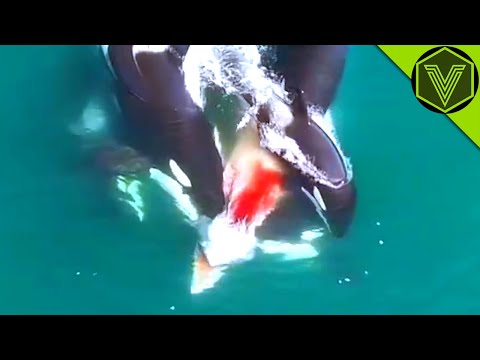Самый опасный хищник океана, и одно из самых умных животных на планете! Встречайте — косатка (Orcinus orca)!
_ _ _ _ _ _ _ _ _ _ _ _ _ _ _ _ _ _ _ _ _ _ _ _ _ _ _ _ _ _ _ _ _ _ _ _ _ _ _ _ _ _ _ _ _ _ _ _ _
►ПОДПИШИСЬ на канал VenterLex, чтобы первым узнать о выходе новых видео!
_ _ _ _ _ _ _ _ _ _ _ _ _ _ _ _ _ _ _ _ _ _ _ _ _ _ _ _ _ _ _ _ _ _ _ _ _ _ _ _ _ _ _ _ _ _ _ _ _
Credits:
Music: Incursion by Machinimasound
Link to Video: https://www.youtube.com/watch?v=4yW82TMt7qo&list=PLSw6t2nRhztp_yaBQNcsI4f9X9eDYzlF9&index=61
Music from #InAudio: https://inaudio.org/
inaudio – Infraction – War
Killer whales can grow up to 10 meters in length and weigh up to 10 tons, making them the largest dolphins in the world. They are common all over the planet, and different populations can differ significantly, both in appearance and in lifestyle. However, all killer whales have very complex social behavior and incredibly high level of intelligence. A typical killer whale family consists of an adult female, its adult sons and calves of various ages. Several related families can unite and form a single pod, in which all individuals maintain friendly relations. But mating occurs only between individuals from different pods, to avoid inbreeding. The basis of nutrition for many populations of killer whales is fish. It can be both small fish, such as herring, and large predators, such as rays and even sharks. When hunting sharks, killer whales are primarily interested in their large liver, rich in fats, proteins and vitamins.
While meat, due to the high content of toxic urea, is rarely eaten. Some killer whales often hunt seabirds. For example, penguins. Catching a king penguin in the water is not easy, as it is significantly surpasses a killer whale in maneuverability. However, the maximum speed of the penguin does not exceed 14 kilometers per hour. While the killer whale can accelerate up to 56 kilometers per hour, gaining an advantage in case of a surprise attack. The diet of killer whales includes about 20 species of pinnipeds, including seals, sea lions and fur seals. When hunting sea lions, killer whales try to isolate the weakest individual from the group and do not allow it to return to shallow water. Then the killer whales exhaust the victim with continuous attacks and stun it with powerful tail slaps.
Finally, the strongest killer whale deals a death blow to the exhausted sea lion. But sea lions cannot feel completely safe even on land. Even adult male elephant seals, the largest pinnipeds, reaching 7 meters in length and 5 tons in weight, can become prey for killer whales. Despite the fact that dolphins are the closest relatives of killer whales, not inferior to them in speed and surpass them in maneuverability, they often become their victims. As well as many other cetaceans, such as porpoises. Killer whales are capable of catching fast and agile dolphins due to well-coordinated collective actions. Each pod of killer whales has its own dialect, a set of unique sound signals that are transmitted from generation to generation through learning and are analogous to human languages. It is a complex communication system, combined with high intelligence, that allows killer whales to successfully hunt not only dolphins, but also the largest animals on the planet. Whales are the main prey for many populations of killer whales.
When hunting a whale, killer whales bite it many times, trying to immobilize it, after which the whale weakened from blood loss is drowned by not allowing it to float to the surface. Even the largest known animal in the entire history of the Earth can become prey. The blue whale. It reaches a length of 33 meters, with a mass of about 200 tons, and for hunting such a giant, killer whales can form huge pods, including more than 75 individuals. Even sperm whales are often attacked, which, despite their strong jaws and social lifestyle, rarely can effectively fight back against killer whales. The hunting techniques of killer whales are extremely diverse and can be very complex and unusual. Getting to a seal resting on an ice floe is not an easy task. But killer whales have found a way. The scout killer whale detects the seal and, using sound signals, coordinates the rest of the pod so that they simultaneously swim right under the ice floe, creating a wave that flushes the seal into the water.
It is not always possible to catch a seal on the first try. But the killer whales do not give up. Captive killer whales are often bored and one of their entertainments is hunting birds over bait. First, the killer whale throws a small fish far ashore to the birds, lulling their vigilance and accustom them not to be afraid of grabbing a treat. Gradually, the killer whale throws fish closer and closer to the water, making no attempt to catch the birds. Finally, the killer whale puts a bait in the most convenient place for attack and waits until one of the birds makes a fatal mistake. There are known cases of captive killer whales attacking humans and even killing them. However, hunger has never been the cause of the attacks. The key factors were much more complicated and associated with the high intelligence of killer whales, including the stress of boredom, loneliness, and separation from a calf.
In the wild, killer whales behave very friendly towards humans. No fatal attacks by wild killer whales have been reported so far. At the same time, killer whales are not afraid of humans and even willingly come into contact with them. Surprisingly, despite their huge size and high number, killer whales are one of the least studied marine mammals. In 1955 the photos of very unusual killer whales living in subantarctic waters were taken. They were filmed for the first time only in 2014. This type is called “type D” and strongly differs in appearance from the other types of killer whales by rounded head with very small white spots, sharper dorsal fin and smaller teeth. In 2019 it was revealed that these killer whales are very different from the others also at the genetic level, and perhaps even belong to a separate species. The total number of all killer whale types is unknown, but it is believed to be quite high, at least 50,000 individuals, of which about half live in Antarctic waters.
If you liked this video, please give it a thumbs up and write your impressions in the comments. Thank you for your attention, bye everyone!
We are excited to present to you the captivating video titled “КОСАТКА — суперхищник, убивающий китов и дельфинов! Косатка против синего кита и морского слона!”. Get ready to embark on a journey of enjoyment, smiles, and laughter as you watch this delightful creation. “КОСАТКА — суперхищник, убивающий китов и дельфинов! Косатка против синего кита и морского слона!” is a perfect blend of entertainment and amusement, carefully crafted to bring joy to your day. From the moment you press play, you’ll be greeted with a cascade of lighthearted moments, heartwarming scenes, and perhaps even a few surprises that will tickle your funny bone.
Whether you’re in need of a quick pick-me-up or simply looking for some light-hearted entertainment, “КОСАТКА — суперхищник, убивающий китов и дельфинов! Косатка против синего кита и морского слона!” has you covered. The video promises to deliver a collection of moments that are bound to leave you grinning from ear to ear. With its engaging content and skillful presentation, “КОСАТКА — суперхищник, убивающий китов и дельфинов! Косатка против синего кита и морского слона!” is more than just a video – it’s an experience designed to brighten your mood and spread positivity.
The creators of “КОСАТКА — суперхищник, убивающий китов и дельфинов! Косатка против синего кита и морского слона!” have poured their creativity and dedication into crafting a visual treat that resonates with audiences of all ages. Through expert storytelling, impeccable timing, and an array of engaging content, “КОСАТКА — суперхищник, убивающий китов и дельфинов! Косатка против синего кита и морского слона!” promises to be an unforgettable journey that lingers in your memory long after the video concludes.
So sit back, relax, and prepare to be entertained as you dive into the world of “КОСАТКА — суперхищник, убивающий китов и дельфинов! Косатка против синего кита и морского слона!”. It’s a delightful video that aims to bring a dose of happiness to your day, leaving you with a lasting smile and a heart full of laughter.
This video was uploaded in youtube and has recieved 46653958 views so far. This is a great achievement and laso it has received 205140 likes and .
Data bout the video:
Rating: ,
Video dimensions: 2d,
Video definition: hd,
Video duration: 00:14:42,
Video favourite count: 0
Video comment count: 6836























